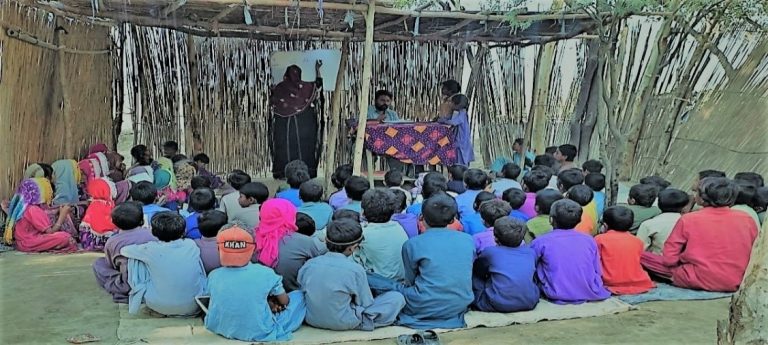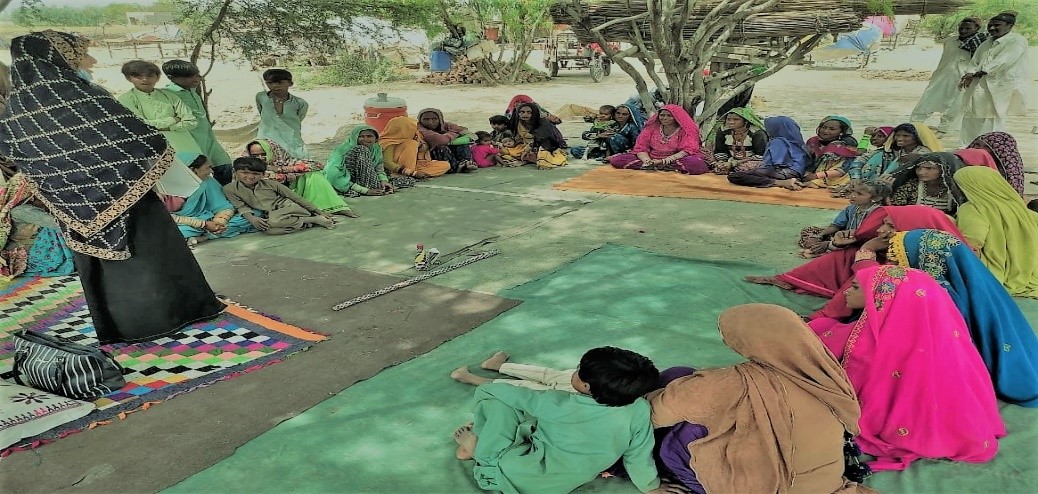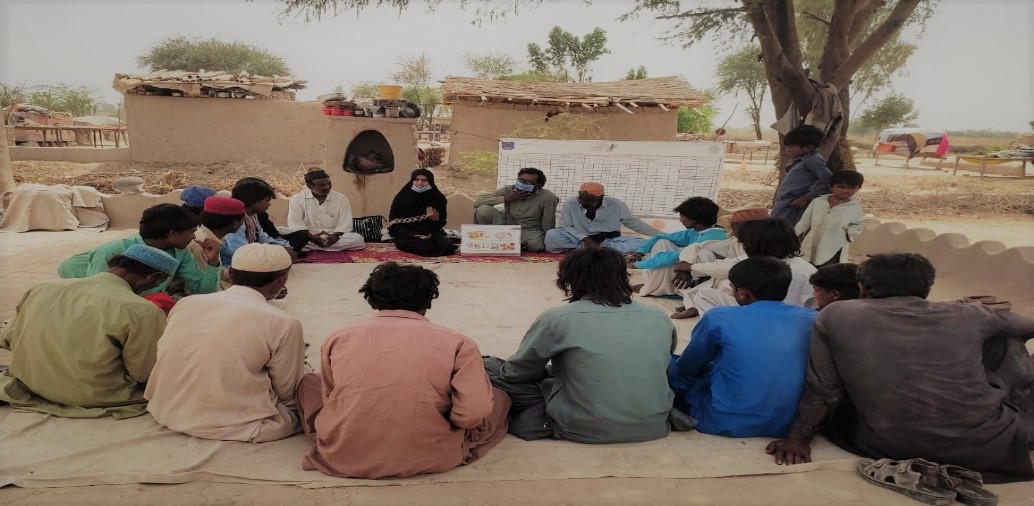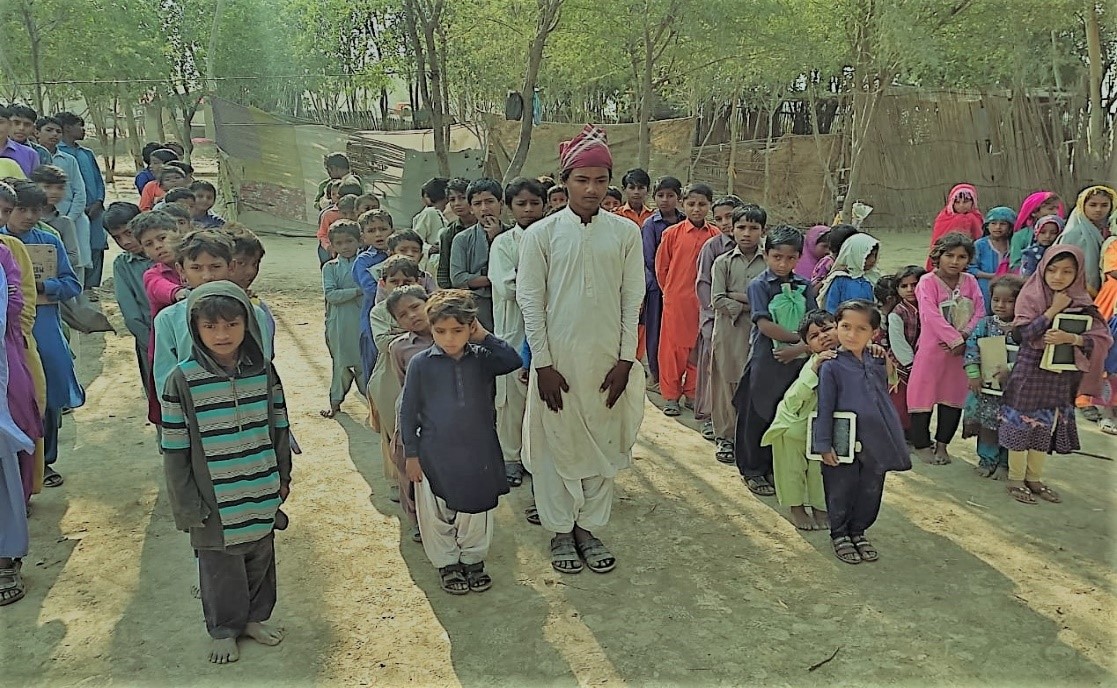
Hailing from the settlement of Mohammad Ismail Mehrani, Paras is the only girl in her village with a Bachelor’s degree.
By Nadir Ali Shah | Amna Ejaz
On February 17, 2022, a rural girl named Paras Mehrani opened the figurative doors to a thatched hut school in her nearby village Jai Ram Jogi. Hailing from the settlement of Mohammad Ismail Mehrani in Tando Allahyar, Sindh, Paras is the only girl in her village with a Bachelor’s degree.
The settlement of Jai Ram Jogi is surrounded by other small settlements such as Mithoo Jogi, Manzoor Pitafi Hari and Mehboob Pitafi Hari, all of which are inhabited by a minority community of the Hindu Jogi tribe. According to the Poverty Score Card survey conducted by National Rural Support Program (NRSP) in 2016, the four sites have 165 households, with a total population of 884. This population comprises of 312 children (ages 5-16), 289 of whom are out of school and only 23 are enrolled at the government school of Moosa Khan Pitafi, which is on average seven kilometers away from the settlements.
The problem of out of school children is a global one. As per the data from UNESCO Institute for Statistics (UIS, 2018), approximately 258 million children and adolescents are out of school worldwide. Of this number, 59 million primary school-age children, 62 million lower secondary and 138 million upper secondary school-age children are not going to school across the globe. The highest rate of out of school children in all grades is 59 million in Sub-Saharan Africa and the second-highest in Southern Asia at 13 million. The World Bank Development Indicators (2020) reports that 8.8% out of school children (primary school years) are in South Asia.
According to a report by Pakistan Education Statistics (2017), out of 51.53 million children (age 5 to 16 years), 22.84 million children do not go to school in Pakistan, which is the second-largest number in the world, leading to the second-lowest literacy rate in South Asia. As per the report, ‘The Missing Third’, released by Pak Alliance for Maths and Science, in Sindh 6.48 million, or 44% of the total children between the ages of 5 to 16 in the province, are out of school. Recently, about 4,901 non-viable schools in Sindh have been closed by the Literacy Department of the Sindh School Education citing reasons such as unavailability of suitable school buildings, low or no enrollment of students, and non-availability of teachers.
The majority of the population of the Hindu Jogi community in the aforementioned four settlements spend their days begging in the streets along with their children. Paras Mehrani, who lives about four miles (6 km) away from these settlements, noticed that many children did not go to school in these areas, and identified a lack of schools in the area as one of the reasons. This is when Paras decided to open a school to enroll out of school children and start teaching them for free. She held separate meetings with women and men of the concerned communities to raise awareness about out of school children and encouraged them to enroll their children in her school free of charge.

Paras states, “I worked hard to open this school. I have been working as a Community Resource Person for the last five years under the community-driven-development based EU-SUCCESS program and have been working with the community women of these four villages and leading awareness sessions on the importance of education and health. I realized that most the of the local children were not going to school so I made up my mind to try to get a small school building in this scattered area of 16 acres. In this regard, I visited government offices such as the office of the Department of Education in Tando Allahyar but I was not successful. So I took the self-help initiative to open this school in a thatched hut with the support of community people.”
So far, Paras has managed to enroll 228 children, of which 166 boys and 62 girls. She also reveals that parents were bringing their children from other nearby villages for admission at her school and she is hopeful that enrollment will further increase in the coming days.

Sustainable Development Goal SDG 4.1 emphasizes that boys and girls must complete free, equitable primary and secondary education by 2030. According to the report of the Asian Development Bank (ADB) ‘School Education in Pakistan’ (June 2019), Pakistan spends on education the lowest percentage of only 2 per cent of the Gross National Product compared to neighboring countries. Its population around 43 per cent is not literate, 55 per cent of women are not literate at the national level, while the situation is worse in the Sindh province, as 80 per cent of rural women are not literate. As per article 26 of the UN declaration that education is a fundamental human right and article 25-A of the Pakistani constitution explicitly emphasizes free and compulsory education for children (5-16 years) in the country. The biggest challenge facing Pakistan is to ensure that all school children must be enrolled in schools. At this point, the decision to open a school on a self-help basis by a rural girl, Paras Mehrani is commendable as it is the need of the hour due to the dire situation in the education sector of Sindh province.
According to Jai Ram Jogi, “The opening of this school in the village is a good sign as our children can get an education to change their lives and be saved from begging on the streets with their parents. I am grateful for Paras Mehrani’s efforts in this charitable act.” In addition, an elder in the village, Mithoo Jogi said, “I never thought in my life that a school could be opened for our children because we are a poor community that no one cares about. But, today I feel like I was wrong as the school opened here. Now, our children can read and write to open their minds.”

Paras Mehrani works as a volunteer teacher without charging a penny from the parents of her students. She did this social work to satisfy her inner and spiritual needs. Locals have begun to recognize her contribution, calling her a social activist, education activist and Malala Yousafzai of Tando Allahyar. While Paras herself sees this act of hers as only a small effort to teach the children, in reality she is providing her students a ray of hope to become productive members of the society in the future.
The story of Paras – a rural girl and the only one with a Bachelor’s degree in her village – is one that teaches many lessons to parents and policy makers alike. It is said that when you educate a girl, you educate a family. In this case, the education of one girl is leading to the education of 228 children. For policy makers, Paras prove the value of volunteers and social entrepreneurs who must be identified and provided with necessary resources to aid in bringing a positive change in the country’s rural areas.
___________________
Nadir Ali Shah is an Anthropologist working as Field Researcher at Rural Support Programs Network (RSPN). He can be reached at nadir.ali@rspn.org.pk
Amna Ejaz is Team Leader Research at Rural Support Programs Network (RSPN). She can be reached at amna.ejaz@rspn.org.pk